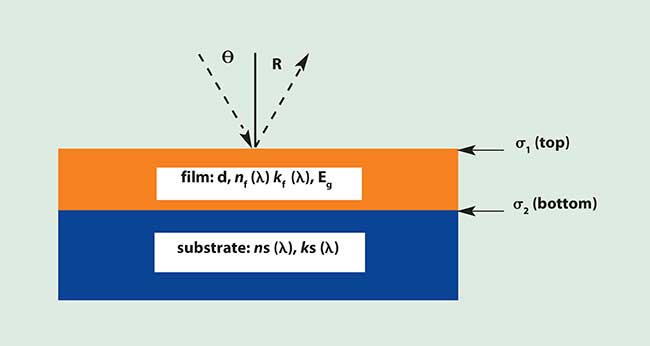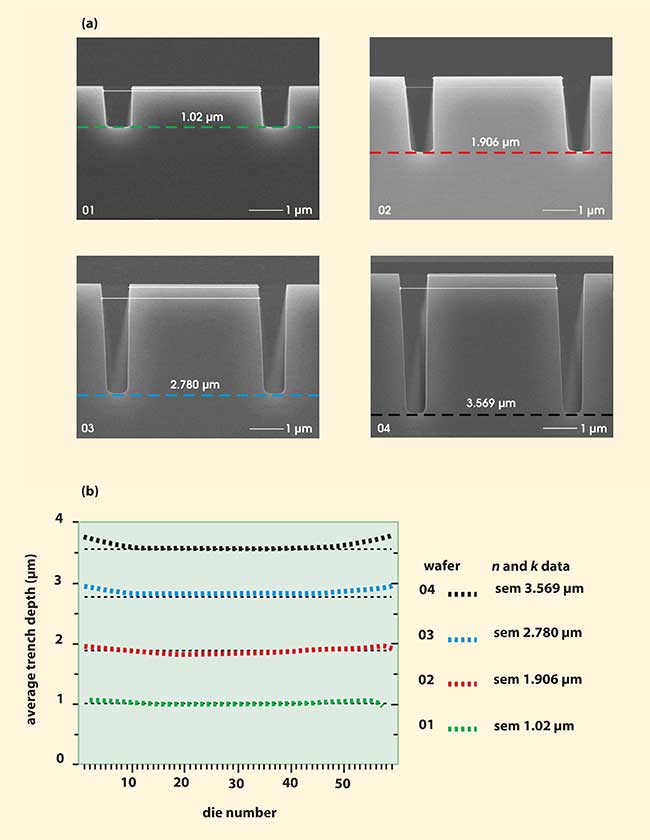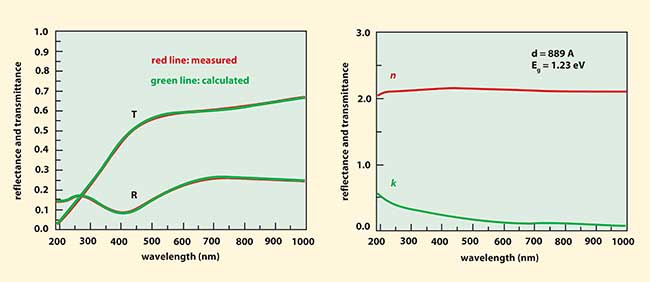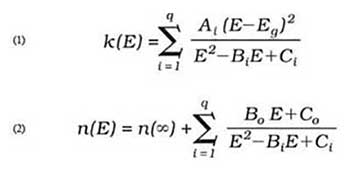Broadband spectrophotometers coupled with relatively simple algorithms can provide fast, nondestructive and comprehensive characterization of thin films.
Iris Bloomer, n&k Technology, Inc.; Rebecca Mirsky, Al Shugart International
Designing devices that incorporate ultrathin films is an important means of enhancing yields. However, characterizing ultrathin films provides a challenge for mainstream metrology tools such as ellipsometers, interferometers and profilometers. One innovative approach is broadband spectrophotometry. When used along with an appropriate physical model for data analysis, it can provide important information about thin-film thicknesses and optical properties in a single, nondestructive step.
Optical characterization of thin films involves the determination of film thickness (d), index of refraction (n) and extinction coefficient (k). The latter two parameters are frequently referred to as optical constants, but the word constant is misleading because the values of n and k actually depend on the wavelength used to make the measurement. That is, the n and k values associated with any particular material may be different at different wavelengths. This is expressed by writing:

Another useful parameter is the film’s energy bandgap (Eg), which represents the minimum photon energy needed for a direct electronic transition from valance to conduction band.
Broadband spectrophotometry works by obtaining reflectance and/or transmittance data over a wide wavelength range. Combined with a valid physical model, the collected data can provide an analysis of a material’s thickness, refractive index, extinction coefficient and energy bandgap.
Appropriate physical model
The physical model is necessary because, in general, spectra for the refractive index and extinction coefficient of any material cannot be measured directly, but must be deduced from optica measurements such as reflectance, transmittance or the phase shift of polarized light. This applies also to a film’s thickness, energy bandgap and interface roughness (σ).

Figure 1. Broadband reflectance spectrum of a single film deposited on an opaque substrate.
The first step in characterizing any thin film is to formulate a theoretical algorithm for reflectance in terms of the n(λ) and k(λ) values for the film and substrate, the film’s thickness and energy bandgap, and the interface roughness (Figure 1). Reflectance (R) is defined as the ratio of the reflected intensity over the incident intensity of light. The measured reflectance spectrum, R(λ), will depend on values for the thickness (d), index of refraction (n), extinction coefficient (k) and energy bandgap (Eg) of the film. It also depends on the n (λ) and k (λ) values of the substrate, the interface roughness — σ1 and σ2 — and the angle of incidence (θ). Although standard Fresnel coefficients address reflectance of multilayer films in terms of the n, k and d values of the film and substrate, they do not address n and k as a function of the wavelength of light. That is, as n(λ) or k(λ).
Incorporating into the Fresnel equations a physically valid description of refractive index and extinction coefficient as a function of wavelength as well as a valid description of interface roughness renders an algorithm for thin-film characterization.
The Forouhi-Bloomer dispersion equations for refractive index and extinction coefficient constitute a physical model that is applicable to a wide range of semiconductor and dielectric materials.1,2 Although the model is typically used to analyze deep-UV to visible (DUV-VIS) reflectance or transmission data (190 to 1000 nm spectral range), it is valid for wavelengths well beyond this range. All the data reported in this article were obtained using a broadband spectrophotometric method with the Forouhi-Bloomer dispersion equations.
Raw data obtained with a spectroscopic ellipsometer is inherently noisy in the DUV wavelength range (i.e., 190 to 300 nm), where important optical information for thin films often occurs; that is, peaks and valleys often occur in the DUV spectral range, which will be obscured, to some degree, when the measurement produces noisy raw data. Also, mainstream tools such as ellipsometers often employ a table of fixed n and k values when setting up a model to determine thickness, even though variations naturally occur during the manufacturing process. In fact, any process change, no matter how minute, can drastically affect the measurement results.
Understandably, these variations can have far-reaching implications in the manufacturing environment. Applying a table of fixed n and k values is especially problematic for ultrathin films and other tightly toleranced applications involving films of regular thickness. Establishing a robust physical model is further complicated when the interface between the layers of film or the substrate surface is rough.
Applications
Traditionally, the characterization of shallow trench systems has relied on time-consuming and highly localized techniques such as atomic force microscopy (AFM) or on destructive methods like scanning electron microscopy (SEM) (Figure 2). Although capable of yielding detailed information, these techniques generally do not accommodate high-throughput sampling. As a result, they do not lend themselves to wafer uniformity studies and have no practical application in volume production or manufacturing environments. In addition, the semiconductor industry’s transition to 300-mm fabrication methods requires even more time for these traditional methods to produce usable wafer characterization data.

Figure 2. Comparative measurements of a series of trench systems indicate that average trench depths measured by broadband spectrophotometry agree with SEM trench measurements. Spectrophotometric data also reveal distinct center-to-edge variations and readily distinguish trench geometry process variations on the order of 100 Å.
Conversely, broadband spectrophotometry based on the Forouhi-Bloomer equations can nondestructively map an entire 300-mm wafer in minutes, returning average results from a measurement spot size ranging from 50 µm to 1 mm, depending on the configuration of the system. Besides accurately measuring standard quantities like trench depth and width, the system also can acquire a wealth of data regarding the thicknesses and properties of films deposited inside and outside of trench regions.
The semiconductor industry’s use of phase-shift masks to reduce feature sizes and to squeeze the most potential out of optical lithography has made characterization of phase-shift materials and masks a requisite for accurate measurement technology. Instruments also must measure transmittance through both the phase-shift material and the substrate at specified wavelengths as well as the film parameters. Specifically, the characterization data must confirm that a mask delivers the ideal phase-shift of 180° as well as specified transmittance in the 5 to 10 percent range.
Because smaller critical dimensions typically rely on shorter exposure wavelengths, it is important to adequately characterize film structures at deep-UV wavelengths. Deep-UV dual-beam laser interferometry provides direct measurements of phase-shift materials and masks. However, this is expensive and is effective at only one wavelength. In addition, it obtains measurements after the mask has been patterned, thus diminishing the possibility of detecting poor mask characteristics prior to patterning. Finally, these interferometers are slow, making mapping inherently difficult.
Broadband spectrophotometry supported by the Forouhi-Bloomer equations simultaneously measures reflectance and transmittance at the same point to determine phase shift, film thickness and the values of n, k and Eg. As demonstrated on a patterned phase-shift mask (Figure 3), the technology can quickly provide a multiple-point map of reflectance and transmittance spectra of a MoSiOxNy film on a quartz substrate. It also can detect nonuniformities in phase shift not only for patterned films, but for blanket films as well. This is particularly important because uniformity of phase-shift masks must be tightly controlled. Other applications require control of phase shift better than ±1° over the entire mask.

Figure 3. Broadband spectrophotometry can provide a 49-point map of reflectance and transmittance spectra of a MoSiOxNy film on a quartz substrate in about 1.5 minutes. Represented here is the experimental and calculated reflectance and transmittance spectra (left), simultaneously measured at the same point of a patterned phase-shift mask. Thickness (d), n and k spectra and Eg appear in the graph on the right.
Broadband spectrophotometry based on these equations can also characterize free-standing SiNx membranes used for Scalpel electron-beam lithography, a promising next-generation lithography technology. Some of the meaningful data obtained for electron-beam techniques includes thickness of the SiNx membrane, values of n and k in the deep-UV and transmittance through the membrane in the DUV. This information helps control the process of making the Scalpel mask and determining its uniformity.
Much data, single measurement
The clear advantage of broadband spectrophotometry is that a single, multiple-wavelength optical measurement can determine many more parameters and film characteristics than can be obtained from instruments designed for specific direct measurements. Spectrophotometric results based on Forouhi-Bloomer equations compare favorably with those obtained using profilometry, AFM and spectroscopic ellipsometry. Also, spectrophotometric measurements are fast, simply made, accurate, repeatable and reproducible. The instrumentation is easily incorporated with fabrication equipment, making it ideal for process control.
The margin for error is shrinking in the manufacture of microelectronic devices and components. As a consequence, demand is growing for greater inspection frequencies and more accurate, rapid, nondestructive and low-cost characterization tools for process development and control. Also, successful metrology tools must provide stable and consistent measurements when faced with normal variations in the manufacturing process. Lastly, new measurement techniques must quickly and accurately determine characteristics such as thickness and uniformity of thin and ultrathin films, and ensure that their integrity is not jeopardized.
Broadband spectrophotometry meets and exceeds the metrology requirements that are necessary to produce high-quality and high-performance protective coatings.
The Enabling Algorithm
With an appropriate physical model to represent the index of refraction (n) and the extinction coefficient (k) of a thin-film material, broadband spectrophotometry can quickly and nondestructively analyze the thickness and optical properties of the film. Equations, developed by A.R. Forouhi and Iris Bloomer, constructed a physical model for n and k in terms of wavelength and material parameters, enabling accurate thin-film characterization simply by measuring reflectance.
The model is applicable to a wide range of semiconductor and dielectric films and fits experimental data over the deep-UV through the near-infrared wavelength range.
The Forouhi-Bloomer equations are given by:
 In these equations, Ε is the photon energy related to the wavelength of light according to Ε = hc/λ, where h is Plank’s constant and c is the speed of light in a vacuum. Εg is the energy bandgap, and A, B and C are related to the electronic structure of the material. The quantities Bo and Co are not independent parameters, but depend on A, B, C, and Εg.
In these equations, Ε is the photon energy related to the wavelength of light according to Ε = hc/λ, where h is Plank’s constant and c is the speed of light in a vacuum. Εg is the energy bandgap, and A, B and C are related to the electronic structure of the material. The quantities Bo and Co are not independent parameters, but depend on A, B, C, and Εg.
Equation 2, for n(Ε), is derived from equation 1, for k(Ε), through the Kramers-Kronig dispersion relation.
Both equations can describe amorphous materials by taking only one term in the sum; that is, by taking the integer q to be equal to one. They describe polycrystalline and crystalline materials by taking the integer q to be equal to two or more.
References
1. Forouhi, A.R. and I. Bloomer (1986). Optical dispersion relations for amorphous semiconductors and amorphous dielectrics. Physical Review Letters B. Vol. 34, p. 7018.
2. Forouhi, A.R. and I. Bloomer (1988). Optical properties of crystalline semiconductors and dielectrics. Physical Review Letters B. Vol. 38, p. 1865.